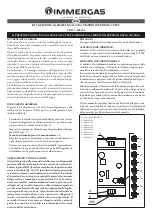
Installation and Operating Manual - SG(S) Fusion
© All rights reserved - Galmet Sp. z o.o. Sp. K.
4
1.4. Remember
1. Before installation of the heater it is recommended to read the installation and user manual that comes with the device.
2. It is not allowed to turn on the heater which is not filled with water.
3. It is not allowed to operate the heater without the proper working safety valve (its functioning must be checked every 14 days – simply turn the
protective hood right or left in the way that causes an outflow from a lateral outlet carrying outside. Next turn the hood in the opposite direction till it
reaches the previous position and press it to the valve's body. If you turn the hood and water does flow out , the valve is inefficient. If you turn the hood
and bring it back to the starting position but water dribbles constantly, the valve's head is polluted and you should rinse the valve opening the outflow
by turning the hood a few times. The outlet carrying water from the valve allows water flow freely outside. To avoid uncontrolled outflow you should
use a funnel or a pipe carrying water to the sewage system. Attention – there is a possibility of hot water flowing . Safety valve dripping excessively
due to: a) constant functioning of water supply with pressure higher than allowed, b) short, sudden leaps of water supply's pressure – are not subject
to a warranty repair or exchange. The company is not responsible for wrong functioning of the safety valve caused by the faulty assembling of the valve
or installation errors e.g. lack of a pressure reducing valve in the installation carrying cold water. Max pressure of the full opening of the safety valve
cannot exceed 1,0 MPa (10 bar).
4. The non-pressure water heaters can only work with non-pressure taps. The water heater must be connected to the tap with a flexible hose and gaskets
in the caps. Next, open the hot water valve (marked in red) and wait till the tank fills with water (as the spout water starts running). In the non-pressure
type water heaters the safety valve function is carried out by the three-way tap.
5. You cannot remove the cover of the heater if it is connected to the power network.
6. In case of cold water existence in the installation supplying it to the heater , non-return valve or another appliance functioning as a non-return valve
e.g pressure reductor you should assemble in the water installation a cumulative membrane vessel with its capacity not lower than 5% of the boiler's
capacity.
7. Within the installation, in which the heater is assembled any appliances causing the so called “water hammer” cannot exist, e.g . ball valve used as a
rinsing valve.
8. It is not allowed to prevent dripping of water from the safety valve – do not block the escape hole of the safety valve. If water leaks continuously from
the safety valve it means that the pressure in the water pipe installation is too high or the safety valve is inefficient. The outlet carrying out of the valve
should be directed down. Below the valve it is advisable to put a funnel carrying the water out. You can also put on the outlet a pipe carrying the water
leakage , appearing when opening the safety valve. The pipe should be resistant to temperature of + 80°C, its inner diameter 9 mm and max length
1,2 m led to the water outlet with a decline (min 3% ) in the surroundings where the temperature does not fall below 0°C. The pipe must be protected
against the decrease of the passage space ( kneading, clogging ), and its outlet should be visible (for checking the valve's functioning).
9. The heater must be turned off immediately if the steam comes out of the battery (it should be reported to the manufacturer).
10. The conductivity of the water should not be lower than 100 μS/cm, this ensures correct operation of the magnesium anode.
11. Constant functioning of the heater at the max temperature causes a faster consumption of the electric parts and the tank.
12. Connecting the heater to the power network without a grounding bolt may result in electrocution in case of a failure of electric equipment.
13. It is not allowed to use within the power circuit any fuse-element above 16 A.
14. At least once a year you should test the heater's protection by measuring the efficiency neutralization.
15. At least every 12 months you should have the service centre rinse any sediment from the heater.
16. To prolong the life of the tank and to ensure the efficient work of the safety valve you should use filters eliminating pollution.
17. If the tanks work in a very aggressive surroundings (e.g. in a barn) you should purchase a product especially designed for working in such surroundings
( producer prepares parts which may get corroded faster, protecting them suitably for chemical reasons.
18. "Galmet Sp. z o.o." Sp. K. reserves the right to introducing any modifications without prior warning of consumers.
19. The heating coil should be flushed by the installer before the first use (besides, installing a filter is recommended to remove any impurities).
20. Please be advised that water odors and the change in colour of the water from the heater to dark indicate the formation of hydrogen sulfide by
reducing sulfate content of the bacteria that live in oxygen-poor water. If cleaning the tank, replacement of the magnesium anode and start with the
temperature above >60°C will not get rid of the problem, we recommend the use of titanium anode connected separately to the mains.
21. All maintenance and installation works must be performed in accordance with applicable health and safety regulations.
1. Operation and maintenance






























